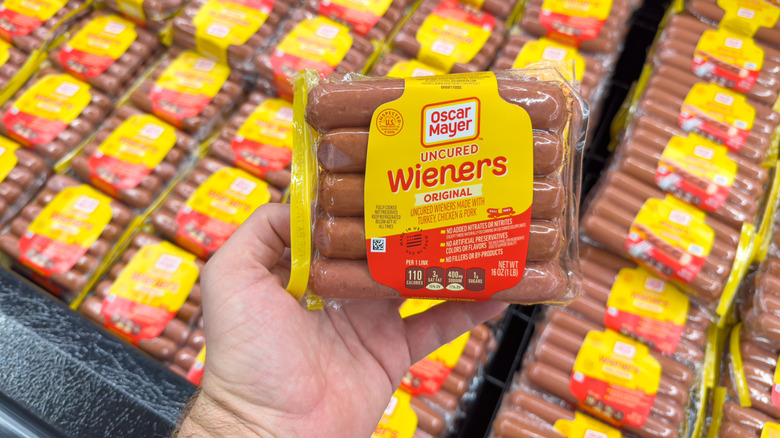Cured Vs Uncured Hot Dogs: What's The Difference Between The Sausages?
A staple of backyard barbecues and tailgate parties, hot dogs are affordable, convenient, and delicious, especially when prepared over open flames. Despite these qualities, this popular food doesn't exactly have the best reputation when it comes to health. While certain hot dog brands insist on using only high-quality ingredients, the vast majority contain preservatives to ensure they remain fresh on store shelves. Understanding how hot dogs are preserved is key to determining the differences between cured and uncured varieties.
Cured hot dogs contain chemicals called nitrites and nitrates, which help maintain food safety but may increase a person's cancer risk. While one might think that uncured dogs don't contain these chemicals, that's not the case. Uncured hot dogs contain the same preservatives, but these chemicals are derived from natural sources (usually celery). On the other hand, the chemical preservatives in cured hot dogs are synthetic. This distinction might seem like a positive one, especially for people who prioritize foods bearing the word "natural" on their labeling, but the health effects of nitrites may be the same, regardless of where they come from.
Are cured hot dogs really that bad for your health?
While both cured and uncured hot dogs contain preservatives, cured hot dogs have received a lot more attention for their potential health effects. To dig into these possible effects, it helps to understand how chemicals actually cure meat. Nitrates and nitrites work in conjunction when preserving hot dogs and other types of meat. The preservation process begins with nitrates, which are transformed into nitrites. Nitrites are then converted into nitric oxide thanks to the addition of protein, and this nitric oxide is what prevents cured meat from spoiling quickly.
Nitrites go through an additional transformation when the proteins they're paired with are subject to high temperatures, which is where the potential cancer risk comes in. This process turns nitrite into nitrosamine, a carcinogen that's also found in cigarette smoke. According to the World Health Organization, studies have shown that a person's chances of developing colorectal cancer increase by approximately 18% for every 50 grams of processed meat they consume on a daily basis. This increased cancer risk is precisely why people should think twice about eating processed meat, including hot dogs, as higher daily consumption only increases the chances of experiencing a serious medical issue.
Uncured dogs have the benefit of good marketing
While uncured dogs containing natural, plant-based sources of nitrites are often touted as a healthier alternative, they likely carry the same health risks as cured meats. Plant-based nitrites can be converted into nitrosamine just like synthetic nitrites, which means this carcinogen could still pose an issue in uncured brands. Additionally, there are no limits imposed on the concentration of natural nitrites that can be included in food, while federal restrictions prevent manufacturers from exceeding a certain concentration of synthetic nitrites. That means a person may buy an uncured brand thinking it contains no chemical preservatives, when in fact it could potentially contain a higher amount than cured hot dogs.
The rules that dictate product labeling on uncured dogs are equally confounding. Manufacturers who use nitrites derived from natural sources, such as celery, must label the product as uncured, as well as stating somewhere on the package that the product doesn't contain any added nitrites or nitrates (although this claim must be accompanied by a caveat that certain ingredients in the dog may contain natural forms of the chemicals). As for truly uncured hot dogs, meaning those without any form of nitrite, they pose more complications than just accelerated spoilage. Nitrites are also what give hot dogs their signature pinkish shade, and consumers might be less enthused about a brand that doesn't appeal to them visually.


